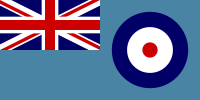- No. 13 Group RAF
-
No. 13 Group RAF 
Group CrestActive 1918 - 1961 Country United Kingdom Branch Royal Air Force Type Group Headquarters Role Defence of the Scotland, Northern Ireland and Northern England Part of RAF Fighter Command Garrison/HQ RAF Newcastle, Tyne and Wear, England Royal Air Force Ensign 
No. 13 Group was a group in the Royal Air Force for various periods in the 20th century. It is most famous for having the responsibility for defending the North of Great Britain during the Battle of Britain
Contents
World War I
No. 13 Group RAF was first formed on 1 April 1918 within No. 3 Area. It was quickly transferred to Midland Area on 8 May of that year. On 18 October 1919 the Group's first existence came to an end when it was disbanded by folding it into No. 3 Group.
World War II
Preparations for War II
As Fighter Command expanded prior to World War II, it was seen that a new Group was needed to command the air defences of Scotland, Northern Ireland, and the north of England. 13 Group was duly reformed on 15 March 1939. During the initial stages of World War II, No. 13 Group was Commanded by Air Vice Marshal Richard Saul.
The Dowding System in 13 Group
Like the other groups into which fighter command were divided, no. 13 Group operated the Dowding System of fighter control. The 13 Group HQ was at Kenton, near Newcastle upon Tyne with the Filter Room at nearby Blakelaw Quarry (not Blakelow, as erroneously mentioned previously).[1]
The sector airfields were[2]:
- RAF Acklington
- RAF Dyce
- RAF Turnhouse
- RAF Usworth
- RAF Wick
Battle Of Britain
As well as guarding the north during the Battle of Britain, 13 Group also provided reserve squadrons and pilots to the more beleaguered 11 Group, and provided quieter bases for squadrons to recuperate from operations.
The 13 Group also contributed to pilot education by producing its "Forget-Me-Nots for Fighters" brochure that included a foreword by Air Vice-Marshal R.E.Saul.[3]
During the Battle of Britain, the Germans had faulty intelligence indicating that 13 Group had next to no fighters in operation (they believed that the only reason why 11 Group was still holding out was that 13 Group had been sending them down their available aircraft), so they had thought that any attacks made on Scotland would not face any serious resistance. This proved to be a costly mistake for the Luftwaffe, as their bombers were intercepted by a large number of fighters. The bombers could not be escorted all the way to Scotland from Occupied Europe because of the short range of the Messerschmitt 109, so the attacking bombers proved to be fodder for Saul's Spitfire and Hurricane squadrons. On August the 15th 1940 the German air force attempted its one and only daylight flank attack on Northern England. North East England was attacked by 65 Heinkel 111s escorted by 34 Messerschmitt 110s, and RAF Great Driffield was attacked by 50 unescorted Junkers 88s. Out of 115 bombers and 35 fighters sent over 16 bombers and 7 fighters were destroyed (Document 32 Battle of Britain Historical Society).
After the Battle of Britain, 13 Group squadrons helped RAF Coastal Command in patrolling for U-boats and providing air cover for convoys. New pilots would usually find themselves posted to a 13 Group squadron initially so as to gain experience with lesser risk of getting shot down.
Post war
After the war, the Group was disbanded on 20 May 1946. However, nine years later it was reformed. It finally disbanded on 31 December 1961 when it was redesignated No. 11 Group.
Commanders
The following officers had command of No. 13 Group:[4]
1918 to 1919
- 1 April 1918 Unknown
1939 to 1946
- 24 July 1939 Air Vice-Marshal R E Saul
- 4 February 1941 Air Vice-Marshal J O Andrews
- 27 November 1942 Air Vice-Marshal M Henderson
- 15 November 1943 Air Vice-Marshal S F Vincent
- 26 January 1944 Air Commodore J A Boret
- 1945 post vacant
- 7 July 1945 unknown
1955 to 1961
- 16 May 1955 Air Vice-Marshal W G Cheshire
- 1 July 1957 Air Vice-Marshal A Earle
- 9 November 1959 Air Vice-Marshal H J Maguire
References
- ^ Subterranea Britannica: Research Study Group: Sites: Kenton Bar 13 Group Fighter Command HQ and Region 1 Regional War Room (RAF Blakelaw)
- ^ The Battle of Britain - Home Page
- ^ p.149-190, Fighting in the Air: The official combat technique instructions for British fighter pilots, 1916-1945, RAF Museum series: Volume 7, John Tanner (gen.ed.), RAF Museum, Hendon, London, Arms and Armour Press, 1978
- ^ http://www.rafweb.org/Grp02.htm
See also
Aerial defence of the United Kingdom during the Second World WarOverview People OthersOrganisation GroupsOther unitsCampaigns and
operationsAircraft Technology Barrage balloon · Battle of the Beams · Radar (Chain Home) · German V weapons
Related topics RAF strategic bombing offensive · United States Army Air Forces
Royal Air Force portal Formations and units Commands · Groups · Stations · Wings · Aircraft squadrons · Aircraft flights · Conversion units · Regiment squadrons

Branches and components RAF Regiment · RAF Chaplains Branch · RAF Intelligence · RAF Legal Branch · Princess Mary's RAF Nursing Service · RAF Police · Search and Rescue Force · Mountain Rescue Service
Reserve forces Associated civil organizations Air Training Corps · RAF Association · RAF Centre of Aviation Medicine
Equipment List of RAF aircraft · List of RAF missiles
Personnel Symbols and uniform History · Timeline · Future Categories:- Military units and formations established in 1918
- Royal Air Force groups
- Battle of Britain
- Military units and formations of the Royal Air Force in World War II
- 1918 establishments in the United Kingdom
Wikimedia Foundation. 2010.
